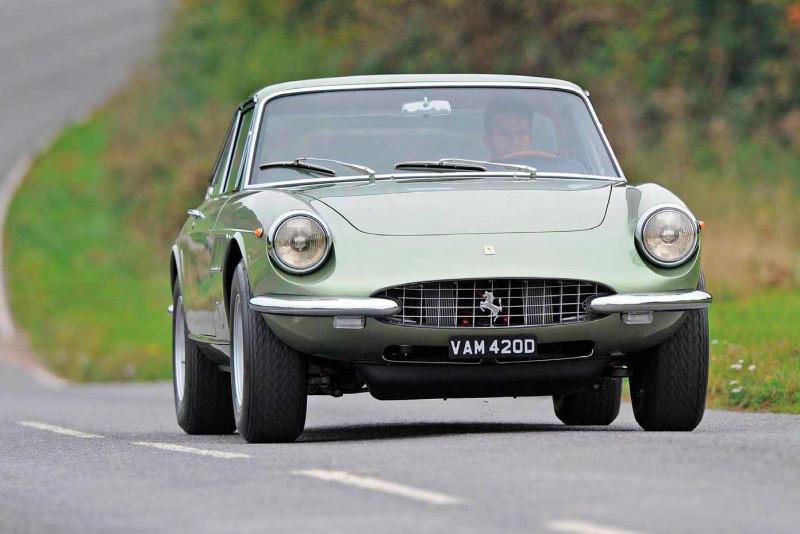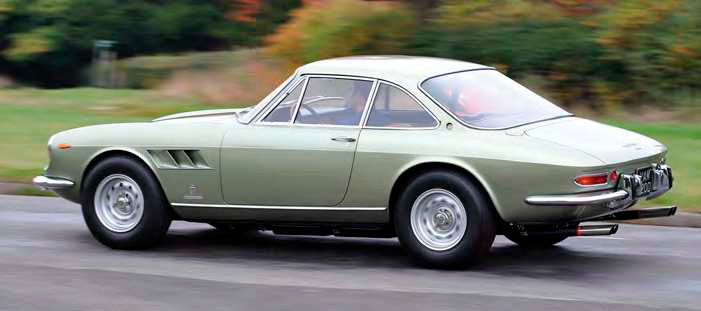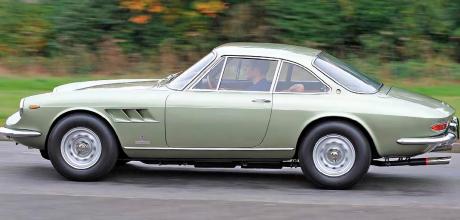Road test 1966 Ferrari 330 GTC
Found abandoned in Venezuela, this Ferrari 330 GTC has now been restored in the UK to concours-winning condition. We tell its story and get behind the wheel.
CARACAS TO CONCOURS
Story by Tim Pitt
Images by Michael Ward/Sam Chick
FERRARI 330 GTC Concours-winning beauty driven
Driving a legend
This sounds like a fairytale. A beautiful classic Ferrari is sold in Switzerland, then rediscovered decades later, half-way around the world in the bustling city of Caracas, Venezuela. Neglected and non-running, yet still remarkably intact, the car is shipped to the UK and restored to its former glory – with a prestigious concours trophy to prove it.

Happily ever after, then? Let’s hope so, but this Cinderella story wasn’t the result of a simple wave of a magic wand. The quest to create ‘the best 330 GTC on the planet’ took three years of obsessive research and painstaking work. Oh, and a lot of walnuts. We’ll come to those later.
“On flowing country roads, I’m soon steering with my fingertips, relishing the 330 GTC’s calm body control, progressive brakes and fleet-footed sense of poise”
Ferrari’s 330 models picked up the baton from the 250 series after 1963. The 330 America arrived first, transplanting a new 4.0-litre version of the Colombo V12 into the 250 GT 2+2. This was swiftly replaced by the 330 GT 2+2, a luxurious grand tourer with styling by Tom Tjaarda – including controversial quad headlights. Enzo Ferrari famously used one as his personal car, perhaps appreciating the contrast with his Mini-Cooper ‘S’.

The two-seat 330 GTC debuted at the Geneva Motor Show in 1966, an event at which its thunder was somewhat stolen by the Lamborghini Miura P400 across the hall. The new coupe borrowed heavily from the 275 GTB, sharing the same 2400mm wheelbase and independent rear suspension. However, the addition of rear side windows and a more opulent interior positioned it as a belated successor to the 250 GT Lusso. In modern Ferrari terms, if the 275 GTB is an 812 Superfast, the GTC feels more closely aligned with the Roma (albeit without rear seats).
Using a ladder frame chassis and steel body – with aluminium for the bonnet, doors and bootlid – the 330 GTC weighed in at 1300kg dry. Its 3967cc Tipo 206/66 V12 developed 300hp at 7000rpm, driving a five-speed transaxle via a fixed torque tube. Ferrari quoted a top speed of 150mph, while period road tests suggest a 0-60mph time of around 6.5 seconds. A total of 600 cars were made, plus 100 examples of the convertible 330 GTS, before the 365 series replaced it in 1968.
“This original 330 GTC is perfect in every detail, yet not so rare or valuable that it never escapes the confines of a heated garage ”
That’s the brief backstory; now to the 330 GTC seen here, which is owned by Christy Chiltern-Hunt. When the car was found in Venezuela, it was painted a sun-bleached shade of pale blue. Photos of the ‘rescue’ show tarnished chrome, a misaligned door and a huge dent in the nearside rear wing. The image of this careworn Ferrari shackled to a metal pallet for shipping feels like it should come with an ‘upsetting scenes’ warning.
After landing in the UK, life-saving surgery was entrusted to Bell Sport & Classic in Hertfordshire. Elliot East, who led the project, had already proven his Ferrari 330 credentials by restoring a 330 LMB recreation, based on a 330 GT 2+2. After driving it last year, I wrote: “As a rolling advertisement for Bell Sport & Classic, the 330 LMB does its job. It’s flawlessly finished and a real talking-point. As a classic Ferrari, it feels authentic without being too priceless to use. And as an experience, it’s unforgettable.”
Spoiler alert: you could swap ‘LMB’ for ‘GTC’ in the above quote and the same sentiments would apply. This original 330 is also perfect in every detail, yet not so rare or valuable (around £650,000 at today’s prices) that it never escapes the confines of a heated garage. And it rewards on the road like only a car with a Colombo V12 can. But we’re jumping ahead, so let’s rewind to 2019 and that battered blue Ferrari on a pallet. “Our goal was a class win at the Salon Privé concours,” explains Elliot, “but we had a long road ahead.”
The process started with two weeks of removing all the interior components, followed by the bumpers, badges, lights and glass. Elliot then spent a month stripping down, sandblasting and refurbishing the suspension components, retaining the original springs, dampers and control arms. The 330 GTC’s brutally kerbed 14-inch cast magnesium wheels were restored to like-new condition, too.
Bell Sport & Classic obtained the factory build sheet, which revealed that chassis 9069 wasn’t originally blue, but Verde Chiaro Metallizato – an understated pale metallic green. And here’s where the walnuts come in. Prior to painting, the Ferrari’s body was blasted with crushed walnut shells. “One of the disadvantages of using sandblasting on the delicate areas of the larger panels is that it can put heat into the steel and cause it to distort,” explains Elliot. “However, that doesn’t happen with walnut-blasting. It’s a technique that’s always best for the potentially more fragile areas.”
The data sheet also showed the 330 GTC left Maranello with a black interior, but owner Christy decided on tan leather for the retrim. O’Rourke Coachtrimmers of West Sussex kept the original seat frames and fitted fresh foam inserts, along with new webbing for the classic Irvin seat belts. All the buckles and brightwork were carefully restored, as was the American walnut veneer on the dashboard (yep, more walnuts). Finally, the anachronistic 1980s cassette player was replaced with a period Becker Europa radio, which was a Ferrari dealer-fit option back in 1966.
The task of rebuilding the engine and gearbox was led by Attilio Romano, a factory-trained engineer who ran HR Owen’s Ferrari technical department for 22 years. Both came together relatively smoothly – unlike the car’s four-pot calliper brake servo, which Elliot says was the most challenging aspect of the rebuild. “Finding a replacement seemed impossible, so the car spent seven weeks in Italy having the part repaired – then it failed again the following day. We eventually found a Jensen-Healey specialist who sorted it, after we discovered the servo is the same.”
As his pièce de résistance, Elliot lifts the boot carpet to show me the glassfibre fuel tanks on either side of the spare wheel, which are finished in a bright turquoise blue. “Most people just paint these black, and that happened here at some stage in the car’s life. But I discovered a fleck of turquoise paint inside one of the filler necks and colour-matched it. Now it looks exactly how it left the factory.”
Overall, Elliot says he retained “99 percent of the original parts”, with the most notable new items – manufactured in-house – being the manifold and exhaust heat shields, plus the glassfibre panel under the radiator. “If you took the car apart, every layer would be as perfect as it looks on the outside,” he says. Such dedication to detail is what secured the Ferrari factory Classiche status, along with a class win at the Salon Privé concours last September. For Elliot, this was mission accomplished.
So, to the driving. I’m aware from past experience that classic Ferraris enjoy sturdy, decisive inputs and plenty of revs (here, peak torque of 288lb ft arrives at 5000rpm). On the flip side, I’m also conscious that this car has covered only a few hundred miles since its rebuild and is absolutely immaculate. I also need to hurry as rain is forecast. No pressure, right?
Even under looming grey clouds, the Ferrari looks fantastic. Its Pininfarina lines meld the long nose of a 500 Superfast with the tapering tail of a 275 GTS, spliced together by an elegant, thin-pillared glasshouse. Perfectly complemented by a subtle colour, it would look equally at home decanting a glamorous couple on to a red carpet as it would roaring up an Alpine pass. Interestingly, it’s also one of the only Ferraris with a model designation on the bootlid.
Opening the door reveals one of the loveliest interiors ever to grace a production car. Soft leather swathes the well-cushioned seats and door cards, the white-on-black Veglia dials looking crisp and the wood-rimmed Nardi wheel wonderfully tactile. Visibility is superb and the car feels reassuringly compact (309mm slimmer than a Roma, in fact).
A huge ashtray sits alongside the open-gate gearbox, its metal lid emblazoned with the Pininfarina logo: a throwback to a more hedonistic age.
The dog-leg first gear demands a weighty shove, and every change needs careful clutch-work until the oil is warmed through. The worm-and-roller steering is also heavy and ponderous at first, but it comes alive at speed. On flowing country roads, I’m soon steering with my fingertips, relishing the 330 GTC’s calm body control, progressive brakes and fleet-footed sense of poise (aided by perfect 50:50 weight distribution). It feels athletic rather than overtly muscular; a car that il Commendatore – who later progressed to a 400 GT, 412 and 456 GT – would surely have enjoyed.
Perhaps inevitably, the legendary Colombo V12 still dominates the experience, more muted here than in some of its siblings, yet still so multi-layered and mechanical. Its three twin-choke Webers and chaindriven cams react instantly to the throttle, the efforts of each 330cc cylinder seeming to redouble as it soars towards a 7000rpm redline – a true sparkle of magic. I make it back to Bell Sport & Classic’s showroom just before the heavens open, saving Elliot from hours of detailing work. He has already started on his next Ferrari restoration, a ‘short nose’ 275 GTB, but it won’t be ready for a while yet. One thing is certain: this outstanding 330 GTC sets a very high bar.
4.0-litre Colombo V12 engine dominates the drive: responsive, revvy and full of mechanical character.
TECHNICAL SPECIFICATIONS 1966 FERRARI 330 GTC
- ENGINE: 3967cc V12
- BORE X STROKE: 77mm x 71mm
- COMPRESSION RATIO: 8.8:1
- MAX POWER: 300hp at 7000rpm
- MAX TORQUE: 390Nm (288lb ft) at 5000rpm
- TRANSMISSION: 5-speed manual, rear-wheel drive
- SUSPENSION: Double wishbones, coil springs,
- telescopic dampers, anti-roll bars
- BRAKES: Discs front and rear
- DIMENSIONS: 4470mm (L), 1665mm (W), 1282mm (H)
- WEIGHT: 1300kg (dry)
- MAX SPEED: 150mph
- 0-62MPH: 6.5sec
Old paintwork was removed using walnut shells (!) and returned to the original Verde Chiaro metallic green


